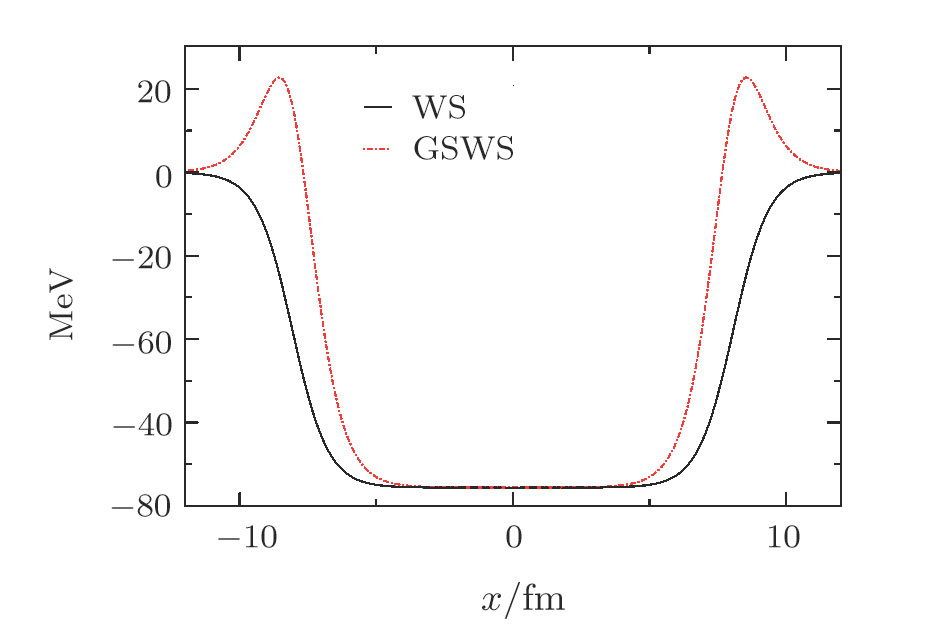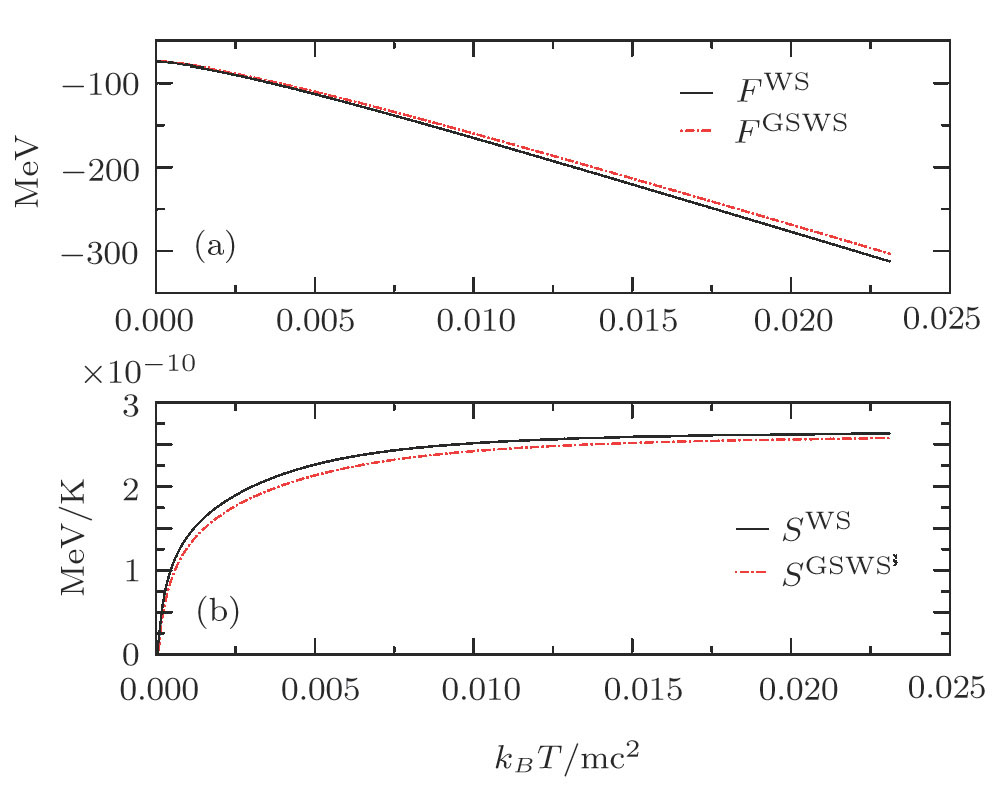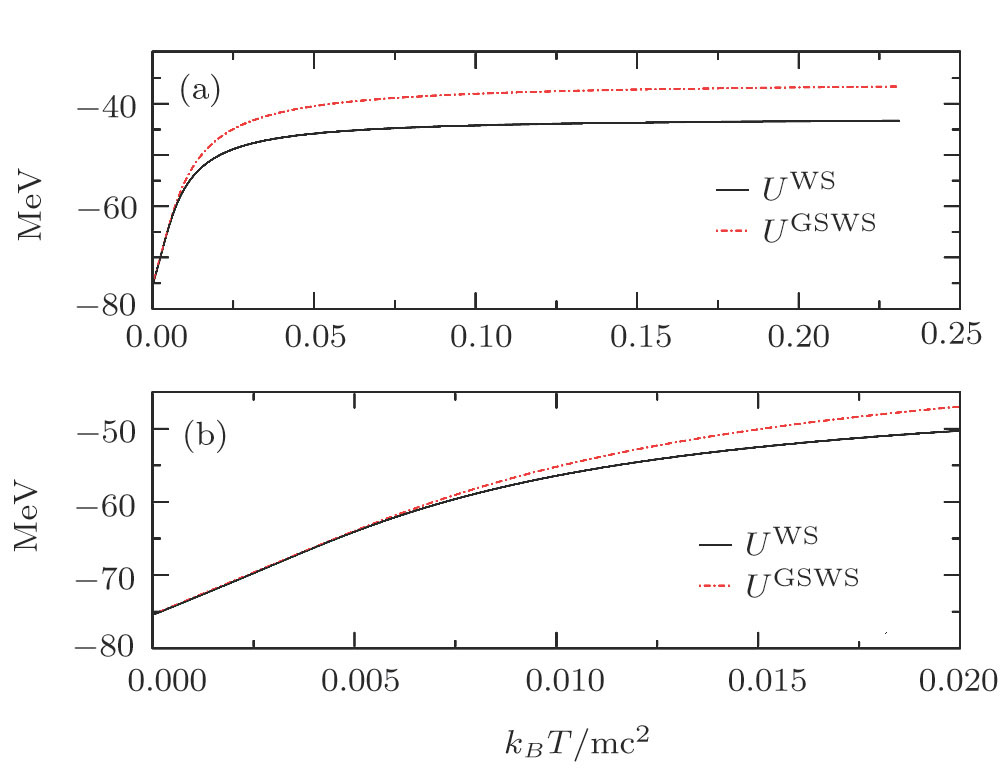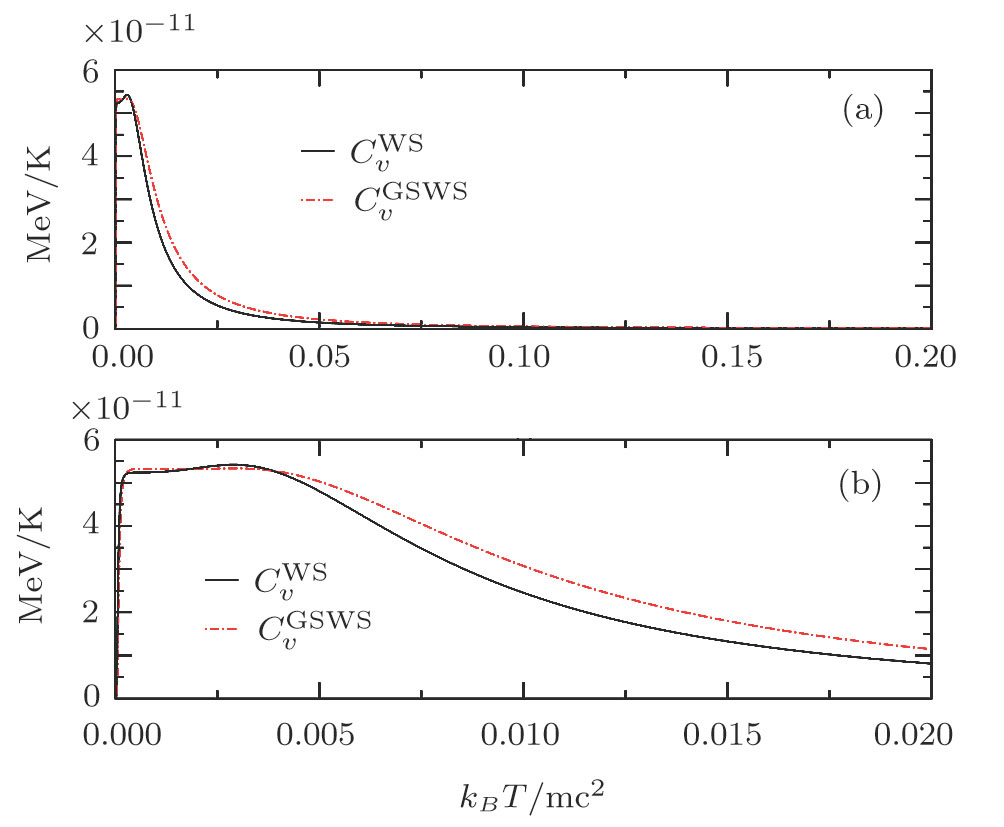† Corresponding author. E-mail:
In this study, we reveal the difference between Woods-Saxon (WS) and Generalized Symmetric Woods-Saxon (GSWS) potentials in order to describe the physical properties of a nucleon, by means of solving Schrödinger equation for the two potentials. The additional term squeezes the WS potential well, which leads an upward shift in the spectrum, resulting in a more realistic picture. The resulting GSWS potential does not merely accommodate extra quasi bound states, but also has modified bound state spectrum. As an application, we apply the formalism to a real problem, an α particle confined in Bohrium-270 nucleus. The thermodynamic functions Helmholtz energy, entropy, internal energy, specific heat of the system are calculated and compared for both wells. The internal energy and the specific heat capacity increase as a result of upward shift in the spectrum. The shift of the Helmholtz free energy is a direct consequence of the shift of the spectrum. The entropy decreases because of a decrement in the number of available states.
In recent years, the thermodynamic functions gained popularity in order to understand the physical properties of numerous potentials in relativistic or non-relativistic regimes. Hassanabadi et al. studied thermodynamic properties of the three-dimensional Dirac oscillator with Aharonov-Bohm field and magnetostatic monopole potential.[1] Pacheco et al. analyzed one-dimensional Dirac oscillator in a thermal bath and they showed that its heat capacity is two times greater than that of the one-dimensional harmonic oscillator for high temperatures.[2] Franco-Villafañe et al. performed the first experimental study on one-dimensional Dirac oscillator.[3] Later, Pacheco et al. also studied three-dimensional Dirac oscillator in a thermal bath.[4] They reported that the degeneracy of energy levels and their physical implications implied that, at high temperatures, the limiting value of the specific heat is three times bigger than that of the one-dimensional case. Boumali studied the properties of the thermodynamic quantities of the relativistic harmonic oscillator using the Hurwitz zeta function. He compared his results with those obtained by a method based on the Euler-MacLaurin approach.[5] Boumali also showed that, with the concept of effective mass, the model of a two-dimensional Dirac oscillator can be used to describe the thermal properties of graphene under a uniform magnetic field, where all thermodynamic properties of graphene were calculated using the zeta function.[6] He also studied the thermodynamics of the one-dimensional Duffin-Kemmer-Petiau oscillator via the Hurwitz zeta function method[7] in which study, he calculated the free energy, the total energy, the entropy, and the specific heat. Larkin et al. have studied thermodynamics of relativistic Newton-Wigner particle in external potential field.[8] Vincze et al. investigated nonequilibrium thermodynamic and quantum model of a damped oscillator.[9] Arda et al. studied thermodynamic quantities such as the mean energy, Helmholtz free energy, and the specific heat with the Klein-Gordon, and Dirac equations.[10] Dong et al. studied hidden symmetries and thermodynamic properties for a harmonic oscillator plus an inverse square potential.[11]
The WS potential well[12] is widely employed to model the physical systems in nuclear,[12–21] atom-molecule,[21–22] relativistic,[23–31] and non-relativistic[32–37] physics problems.
To describe the energy barrier at the surface of atomic nucleus that nucleons are exposed, various type of additional terms to WS potential are proposed to produce GSWS potentials. Such potential wells can be used to model any system, in which a particle is trapped in a finite space, as well as the effects, such as non-zero l, spin-orbit coupling.[38–55]
Our main motivation in this work is to compare physical consequences of the two potentials in context of quantum mechanics and statistical thermodynamics. We consider the physical properties of α particle as an application, to reinforce the formal treatment of the two potentials for Bh-270 nucleus.
In sec.
The WS potential well in one dimension is described by



According to the assumption that a nucleon suffers a potential barrier when near the surface of its nucleus or being emitted to outside, the WS potential is considered inadequate to explain the dynamics of this type of problems. In order to take the surface effect into account, an additional term to the WS potential is widely used.[39–41] The WS potential combined with the additional terms are called GSWS potential.

Because of the symmetry of the potential, even 













The energy spectrum of a nucleon under GSWS potential is composed of energy eigenvalues, satisfying

Using the energy eigenvalues En, the partition function of the system is given by









In this section we present the thermodynamic treatment of an α particle within Bh-270 nucleus as an application of the formalism described in previous sections, in order to investigate the effects of the surface term addition to the WS potential. For this nucleus, in Ref. [14] the inverse diffusion parameter is given as a = 1.538 fm−1, while the radius is evaluated to be L = 8.068 fm. Substituting the atomic number A = 270 into Eq. (

The calculated energy spectra of an α particle with mass m = 3727.379 MeV/c2 in the nucleus are tabulated in Tables
| Table 1
The energy spectrum of the α particle within Bh-270 nucleus under WS potential well assumption. . |
| Table 2
The energy spectrum of the α particle within Bh-270 nucleus under GSWS potential well assumption. The rightmost column tabulates the quasi-bound energy levels. . |
Using the partition function given in Eq. (

The addition of the surface term leads to increase in the internal energy as observed in Fig.
In Fig. 

In this study, we analyze the effect of the additional term, representing the surface effect of a nucleus, to WS potential well. We formally discuss how the additional term modifies the whole non-relativistic energy spectrum by squeezing the well, resulting in an upward shift of the spectrum. GSWS potential does not merely accommodate extra quasi bound states, but also has modified bound state spectrum. As an application of the formal treatment, we consider α particle inside Bh-270 nucleus, modeled with both WS and GSWS potential wells. The thermodynamic functions Helmholtz free energy, entropy, internal energy, specific heat are calculated in both approaches and compared. The internal energy and the specific heat capacity increase, as a result of upward shift in the spectrum. The shift of the Helmholtz free energy is a direct consequence of the shift of the spectrum. The entropy decreases due to the decrement in the number of available states, which arises as a result of narrowing the well with the additional term. It is concluded that GSWS potential is more realistic to describe the physical properties of α particle within Bh-270 nucleus.
| [1] | |
| [2] | |
| [3] | |
| [4] | |
| [5] | |
| [6] | |
| [7] | |
| [8] | |
| [9] | |
| [10] | |
| [11] | |
| [12] | |
| [13] | |
| [14] | |
| [15] | |
| [16] | |
| [17] | |
| [18] | |
| [19] | |
| [20] | |
| [21] | |
| [22] | |
| [23] | |
| [24] | |
| [25] | |
| [26] | |
| [27] | |
| [28] | |
| [29] | |
| [30] | |
| [31] | |
| [32] | |
| [33] | |
| [34] | |
| [35] | |
| [36] | |
| [37] | |
| [38] | |
| [39] | |
| [40] | |
| [41] | |
| [42] | |
| [43] | |
| [44] | |
| [45] | |
| [46] | |
| [47] | |
| [48] | |
| [49] | |
| [50] | |
| [51] | |
| [52] | |
| [53] | |
| [54] | |
| [55] | |
| [56] | |
| [57] |








